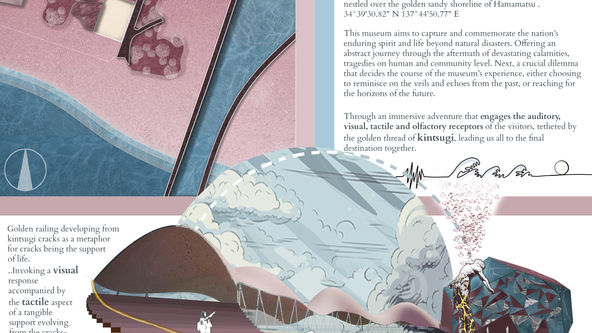The Zen tempest: A sensory museum unraveling the scars of Japan
Pranav Batra, Deepanjana Das & Het Parikh
India


© Pranav Batra, Deepanjana Das & Het Parikh

© Pranav Batra, Deepanjana Das & Het Parikh


© Pranav Batra, Deepanjana Das & Het Parikh
The great Island nation, Japan, has been plagued by natural calamitic forces throughout history. This paints quite a somber imagery of its catastrophic impact on human life. Life and death go hand in hand, all that remains, are the eternal scars on a devastated land, generations of trauma and gradual healing at the very end, the everlasting circle of life.
The museum thus aims to encapsulate this journey from calamity to peace, a sensorial odyssey of the land of Japan and its natural forces and artful healing -the final destination. It stands as a sanctuary depicting a tale of the aftermath of calamities, the lives of the victim and the gallant spirit of the survivors. As the visitors would navigate within the museum, engaging their auditory, visual, tactile and olfactory senses, they would experience a myriad of emotions, ranging from angst, sorrow, misery, hope, grit, nostalgia, empathy, peace and so on. The design achieves this by incorporating interactive tactile walls, rhythmic level differences, creating astounding visuals through light effect and transparency, accompanied by echoes of the ocean waves afar.
The first stage of the design and core concept has been drawn from the Japanese philosophy of ‘Kintsugi’ (an art of repairing broken crockeries with gold, reuniting the pieces and creating something unique and brand new). The cracks are synonymous to human predicament and this emphasizes the importance of healing and overcoming the traumas of life. Visually, these cracks also tend to resemble the scars of a land devastated by earthquakes and tsunamis. The occurrence of these tragedies often presents us with two possibilities
- To succumb into the sorrows of yesterday, fixate on the pangs of the past, into the bbbbbbbbbbb‘labyrinth of grief’ and also compelling the visitors to re-live and empathize with the bbbbbbbbbbb somber fate of the victims.
-To march forward with vigor, overcome the adversities of the past, focus on the future and bbbbbbbbbbbembrace the ‘horizons of hope’. Commemorating the heroic spirits of the survivors.
After entering the first dome, a kaleidoscopic imagery of the ocean and reflected colorful lights greet the visitors, leading them to the second stage, wherein we segregate the aforementioned two trajectories further, ending up with the- ‘Labyrinth of grief’ and the ‘Horizons of hope’. This embodies the duality of humans, the contrasting individualistic pursuits and approach towards their lives. When visitors are presented with the dilemma of walking down these two pathways, based on their respective personalities, they’ll be led through an incredible journey of empathy and self-discovery. The pathway, ‘Labyrinth of grief’- is riddled with thought provoking visuals, disturbing revelations, uncanny sounds all embodying the dark natural catastrophes of Japan. ‘Horizons of hope’ – a pathway that stands for optimism, growth, artful healing and possibilities of the future. Both the trails would diverge from the entrance and eventually reconnect and spill into a bright open space with a central installation, the journey of a lifetime reaching a final beautiful end.



